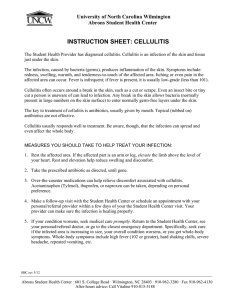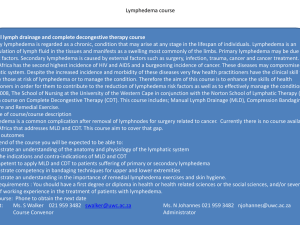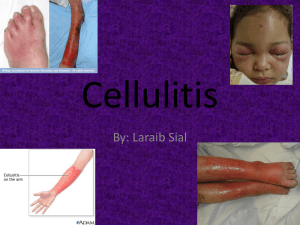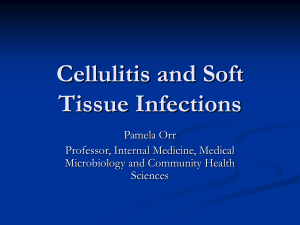Document 14240166
advertisement
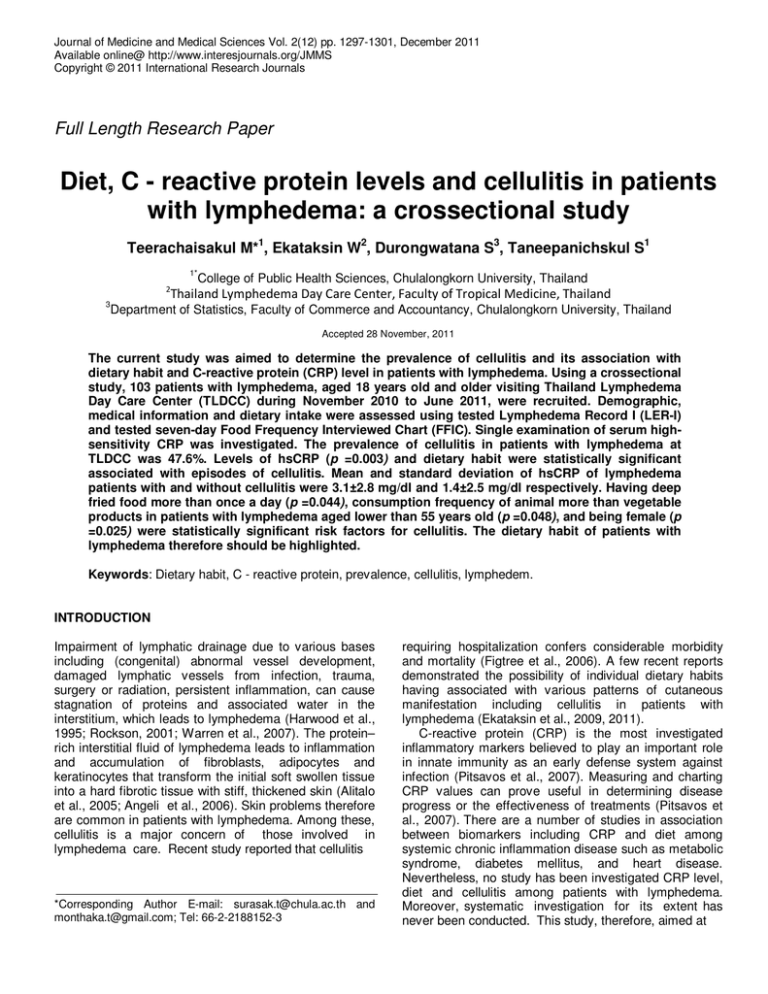
Journal of Medicine and Medical Sciences Vol. 2(12) pp. 1297-1301, December 2011 Available online@ http://www.interesjournals.org/JMMS Copyright © 2011 International Research Journals Full Length Research Paper Diet, C - reactive protein levels and cellulitis in patients with lymphedema: a crossectional study Teerachaisakul M*1, Ekataksin W2, Durongwatana S3, Taneepanichskul S1 1* 2 College of Public Health Sciences, Chulalongkorn University, Thailand Thailand Lymphedema Day Care Center, Faculty of Tropical Medicine, Thailand 3 Department of Statistics, Faculty of Commerce and Accountancy, Chulalongkorn University, Thailand Accepted 28 November, 2011 The current study was aimed to determine the prevalence of cellulitis and its association with dietary habit and C-reactive protein (CRP) level in patients with lymphedema. Using a crossectional study, 103 patients with lymphedema, aged 18 years old and older visiting Thailand Lymphedema Day Care Center (TLDCC) during November 2010 to June 2011, were recruited. Demographic, medical information and dietary intake were assessed using tested Lymphedema Record I (LER-I) and tested seven-day Food Frequency Interviewed Chart (FFIC). Single examination of serum highsensitivity CRP was investigated. The prevalence of cellulitis in patients with lymphedema at TLDCC was 47.6%. Levels of hsCRP (p =0.003) and dietary habit were statistically significant associated with episodes of cellulitis. Mean and standard deviation of hsCRP of lymphedema patients with and without cellulitis were 3.1±2.8 mg/dl and 1.4±2.5 mg/dl respectively. Having deep fried food more than once a day (p =0.044), consumption frequency of animal more than vegetable products in patients with lymphedema aged lower than 55 years old (p =0.048), and being female (p =0.025) were statistically significant risk factors for cellulitis. The dietary habit of patients with lymphedema therefore should be highlighted. Keywords: Dietary habit, C - reactive protein, prevalence, cellulitis, lymphedem. INTRODUCTION Impairment of lymphatic drainage due to various bases including (congenital) abnormal vessel development, damaged lymphatic vessels from infection, trauma, surgery or radiation, persistent inflammation, can cause stagnation of proteins and associated water in the interstitium, which leads to lymphedema (Harwood et al., 1995; Rockson, 2001; Warren et al., 2007). The protein– rich interstitial fluid of lymphedema leads to inflammation and accumulation of fibroblasts, adipocytes and keratinocytes that transform the initial soft swollen tissue into a hard fibrotic tissue with stiff, thickened skin (Alitalo et al., 2005; Angeli et al., 2006). Skin problems therefore are common in patients with lymphedema. Among these, cellulitis is a major concern of those involved in lymphedema care. Recent study reported that cellulitis *Corresponding Author E-mail: surasak.t@chula.ac.th and monthaka.t@gmail.com; Tel: 66-2-2188152-3 requiring hospitalization confers considerable morbidity and mortality (Figtree et al., 2006). A few recent reports demonstrated the possibility of individual dietary habits having associated with various patterns of cutaneous manifestation including cellulitis in patients with lymphedema (Ekataksin et al., 2009, 2011). C-reactive protein (CRP) is the most investigated inflammatory markers believed to play an important role in innate immunity as an early defense system against infection (Pitsavos et al., 2007). Measuring and charting CRP values can prove useful in determining disease progress or the effectiveness of treatments (Pitsavos et al., 2007). There are a number of studies in association between biomarkers including CRP and diet among systemic chronic inflammation disease such as metabolic syndrome, diabetes mellitus, and heart disease. Nevertheless, no study has been investigated CRP level, diet and cellulitis among patients with lymphedema. Moreover, systematic investigation for its extent has never been conducted. This study, therefore, aimed at 1298 J. Med. Med. Sci. exploring the prevalence of cellulitis and its association with diet and CRP level in patients with lymphedema at Thailand Lymphedema Day Care Center (TLDCC). MATERIALS AND METHODS Ethical consideration Ethics approval was obtained from the Ethical Review Committee for Research Involving Human Research Subjects, Health Sciences Group, Chulalongkorn University (ECCU) code: 132.1/53 with permission from the Dean of Faculty of Tropical Medicine, Mahidol University. All participants were requested to complete the inform consent. Confidentially was ensured through a number coding system replacing participants’ name. Design and Sample A cross-sectional study design was assigned in the present study. The participants were new outpatients visiting TLDCC during November 2010 to June 2011. One hundred and three patients with lymphedema were recruited with simple random sampling technique. The inclusion criteria were; (a) patients aged 18 or older with diagnosis of extremities lymphedema and able to give a personal interview him/herself (b) no food allergies history (c) no medical diagnosis of metastasis of cancer and (d) no changes in dietary pattern before visiting TLDCC. Instruments and Procedures Demographic and medical information including self reported age, education, duration of suffering, trigger factors, history of cellulitis and food induced complication experiences (FIE) were accessed by tested Lymphedema Record I (LER-I). Agreement of self reported information was reinvestigated at three month apart from the first investigation. About 59.2% completed a second LER-I report. Kappa coefficient (K) ranged from 0.67 to 0.97 at p< 0.001 suggested moderate to high agreement of the reproducibility of LER-I. Cellulitis was identified when at least three symptoms were recalled included increasing of swelling or tightness, erythematic of lymphedematous tissue, and heat for both localization or systematic. Three stages of unilateral lymphedema severity were indicated by standard measurement of percent circumference difference. FIE history was interviewed and identified only if patients were able to report undesired symptoms induced by food and type of causation food, and its onset within 48 hours. In this study, FIE must occur only at lymphedematous tissue and after lymphedema diagnosis. Dietary details were obtained by using a tested seven days Food Frequency Interviewed Chart (FFIC). The food items were classified into two main categories (r=0.74, p=0.002): 12 items of animal products and 16 items of vegetable products including rice, grains and fruits. Seven cooking methods (r=0.63, p=0.01) were also included in seven days-FFIC. Personal face to face interview was conducted through using the tested LER-I and seven days-FFIC, which were performed on the first day of TLDCC visiting. Serum high-sensitivity C-reactive protein (hs CRP) was measured by the BN ProSpec® (Siemens, Germany). The single test was assayed on the first day prior to the treatment program. Agreement on CRP test was asked separately. Seventy-one from one hundred and three voluntary enrolled to the investigation. However, seven patients were dropped out as they were not able to enter the treatment program within three weeks after interviewed. Statistical Analysis Statistical evaluation was estimated using descriptive statistic, univariate and bivariate analysis. To describe the data, median, standard deviation, percentage and frequencies were processed. To compare continuous variables including age, body mass index (BMI), hsCRP and percent circumference difference between two groups (cellulitis and non-cellulitis), normality test was performed using the Kolmogorov-Smirnov criterion. hsCRP levels were log transformed because of their skewed distributions. Independent T-test then was calculated with checking for equality of variances using the Levene test. Chi-square or fisher’s exact test was carried out for nominal and categorical variables. All reported P values were two- sided tests. Significance level was determined at 0.05. Statistical package software (SPSS version 16.0) was utilized for all statistical analyses. RESULTS Summary of the obtained data are illustrated in Table 1. Participants were divided into two groups according to cellulitis history: non-cellulitis and cellulitis. Mean and standard deviation of age and BMI were 55.3±12.6 years old, and 27.1±5.9 kg/m2 respectively. Female was accounted for 88.3% of all patients. Forty-nine from 103 patients with lymphedema indicated experiences of cellulitis giving a prevalence of 47.6%. With 18.4% reported food induced complication experiences in their past history. Teerachaisakul et al. 1299 Table 1. Characteristic of patients with lymphedema (LE) by cellulitis history Sociodemographic Age (yrs; means ± SD) † Male sex , no. (%) Education-less than 12 yrs, no. (%) Duration of suffering-more than five years, no. (%) Clinical and biological hsC-reactive protein level (mg/L; means ± SD), (n = 62) 2 Body mass index (kg/m ; means ± SD) †† Primary LE diagnosis , no. (%) Bilateral LE, no. (%) Percent-circumference difference (means ± SD), (n = 81) Hypertension Diabetes Mellitus Diet Food-induced-complication-experiences, no. (%) Consumption frequency of Animal > Vegetable ‡, no. (%) Consumption frequency of Animal > Vegetable §, no. (%) Deep fried food consumption > once a day, no. (%) † †† 2 All LE n = 103 LE without cellulitis n = 54 LE with cellulitis n = 49 p-value 55.3±12.6 12 (11.7) 53 (51.5) 33 (32) 55.1±12.6 4 ( 33.3) 27 (50.9) 12 (36.4) 55.6±12.7 8 (66.7) 26 (49.1) 21 (63.6) 0.84 0.047* 0.76 0.025* 2.0±2.8 27.1±5.9 24 (23.5) 21 (20.4) 17.2 ±1.1 37 (35.9) 14 (13.6) 1.4±2.5 26.6±5.3 9 (37.5) 11 (52.4) 13.1 ±1.1 18 (48.6) 7 (50) 3.1±2.8 27.7±6.5 15 (62.5) 10 (47.6) 21.9±12.8 19 (51.4) 7 (50) 0.003* 0.35 * 0.036 0.99 <0.001* 0.56 0.84 19 (18.4) 29 (28.2) 4 (21.1) 11 (37.9) 15 (78.9) 18 (62.1) 10 (9.7) 2 (20) 8 (80) 0.004* 0.048* 0.025* 0.044* ‡ Unilateral LE Controlled, Obesity Controlled (BMI ≥25 kg/m ), Aged less than 55 Controlled, and § Female gender Controlled * p < 0.05 indicated significant difference between LE without cellulitis and LE with cellulitis. Univariate and bivariate analysis displayed duration of suffering more than five years (p=0.025), hsCRP level (p=0.003), percent circumference difference (<p=0.001), FIE (p=0.004), and deep fried food consumption more than once a day (p=0.044) as statistically significant risk factors for cellulitis. Male gender (p=0.047), primary lymphedema diagnosis (p=0.036) and consumption frequency of animal more than vegetable products were found to be the significant risk factors when unilateral LE, obesity, and aged less than 55 years old (p=0.048) and of female gender (p=0.025) were controlled sequentially. Table 2 shows the descriptive information associated to cellulitis and FIE. Thirty three patients (67.3%) experienced more than one episode of attack with 9.7% experienced more than 10 episodes of its recurrent. Nearly half of the patients (44.9%) used to hospitalize in the history. Overused of lymphedematous organ (44.1%) was the most trigger factor for cellulitis reported by the patients. Main source of food induced complications was animal products (84.2%), which crustacean products were identified as the most (26.9%) trigger followed by red meat (23.1%) and fish (19.2%). Consumption of salted or prickled food (68.4%) was reported as the top of food induced complications. Almost half of lymphedema with FIE (42.1%) indicated onset of FIE reaction within 12 hrs. DISCUSSION The purpose of this study was to explore the prevalence of cellulitis and its association with diet and CRP level in patients with lymphedema at TLDCC. The subjects of the current study were 103 patients with lymphedema aged 18 years old and older. It was found that the prevalence of cellulitis among patients with lymphedema was 47.6%. The factors, which statistically associated with cellulitis in patients with lymphedema, were male gender, hsCRP level, primary lymphedema diagnosis, percent circumference difference (LE severity), FIE, consumption frequency of animal more than vegetable products and deep fried food consumption more than once a day. Our major finding is that among patients with lymphedema, higher levels of hsCRP and dietary habit were associated with cellulitis episodes. Salted and/or prickle foods especially animal products were reported harmful to lymphedema with cellulitis. Habitually of having deep fried food more than once a day and consumption frequency of animal more than vegetable products in patients with lymphedema aged lower than 55 years old and of female gender resulted in attack of cellulitis. In support of previous report suggested prevalence of cellulitis among Japanese is seen in about a half of the 1300 J. Med. Med. Sci. Table 2. Descriptive information related to cellulitis and FIE. Cellulitis Recurrent cellulitis Number of cellulitis-more than 10 episodes Was there any hospitalization? (Y) Were there any trigger factors for it? (Y) Overused of organ Food induced complication experiences (FIE) Number of FIE-less than 5 times Onset of action-within 12 hrs Induced by animal products Crustacean Red meat Fish Cooking type of causation food Salted and/or Prickle Grilled patients with lymphedema (Ohkuma, 1998). Higher risk of cellulitis among males has been reported in some studies (Ellis Simonsen et al., 2006; Lamagni, 2008). However, our finding on BMI is in consistent with previous studies that have demonstrated BMI was a risk factor of recurrent cellulitis (Helyer et al., 2010; Karppelin et al., 2010). Our data demonstrated BMI mean of LE with cellulitis was higher than LE without cellulitis but failed to prove statistically significant. Possible explanation could be the subject group of the study was different. Our patients were generally chronic lymphedema, the majority of them were obese. The results of the present study, furthermore, offer support for the belief that dietary habits are one of the key determinants of the balance that influences the overall inflammatory process in chronic conditions (Bullo et al., 2010). Association between dietary habit and inflammation has been reported by several authors. A few recent studies support that a high consumption of cereal and dietary fiber can improve inflammation (Esposito et al., 2003). Diets rich in Trans-or saturated fatty acids are more closely associated with vascular inflammation resulted in increasing of biomarkers such as CRP (Bullo et al., 2010; Lopez-Garcia et al., 2005). Our findings may state a hypothesis that in lypmphedema patients with cellulitis having low grade systemic inflammation, as reflected by higher level of hsCRP in their serum, could be modulated their recurrent acute episode of cellulitis through dietary control. Consuming animal products in small proportion and avoiding deep fried food may prevent or delay cellulitis episodes among patients with lymphedema. Nevertheless, to the best in our knowledge, this is the first systematic study demonstrates significant relationship between dietary N (%) 49 (100) 33 (67.3) 10 (9.7) 22 (44.9) 34 (69.4) 15 (44.1) 19 (100) 14 (73.7) 8 (42.1) 16 (84.2) 7 (26.9) 6 (23.1) 5 (19.2) 13 (68.4) 4 (21.1) habit, hsCRP levels and subcutaneous tissue inflammation in patients with lymphedema. We provide the statistically significant data reveal that higher level of hs CRP and some dietary habit could lead to cellulitis provocation. ACKNOWLEDGEMENTS This study was financially supported by THE 90th ANNIVERSARY OF CHULALONGKORN UNIVERSITY FUND (Ratchadaphiseksomphot Endowment Fund). REFERENCES Alitalo K, Tammela T, Petrova TV (2005). Lymphangiogenesis in development and human disease. Nature. 438: 946. Angeli V, Randolph GJ (2006). Inflammation, lymphatic function, and dendritic cell migration. Lymphat Res. Biol. 4: 217. Bullo M, Casas-Agustench P, Amigo-Correig P, Aranceta J, SalasSalvado J (2010). Inflammation, obesity and comorbidities: the role of diet. Public Health Nutr. 10: 1164-1172. Ekataksin W, Chanwimalueang N, Oyama K, Suebtrakul P, Watcharapornpakdee A, Piyaman P, Hanboon BK (2009). Food Aggravation in Lymphedema: A New Light in Morbidity Control for Lymphatic Filariasis and Beyond. Proceedings of the Joint International Tropical Medicine Meeting 2009 Dec 3rd -4th , Faculty of Tropical Medicine, Mahidol University, Bangkok, Thailand. pp. 6566. Ekataksin W, Chanwimalueang N, Teerachaisakul M (2011). Food aggravation: Effect of dietary habits studied in 2300 patients with rd lymphedema. Proceedings of the 23 International Congress of th rd Lymphology 20011 Sept 19 -23 , Malmoe, Sweden. pp. 101 Ellis Simonsen SM, Van Orman ER, Hatch BE, Jones SS, Gren LH, Hegmann KT, Lyon JL (2006). Cellulitis incidence in a defined population. Epidermiol infect. 134: 293-299. Teerachaisakul et al. 1301 Esposito K, Pontillo A, Di Palo C, Giugliano G, Masella M, Marfella R, Giugliano D (2003). Effect of weightloss and lifestyle changes on vascular inflammatory markers in obese women: a randomized trial. JAMA. 289: 1799-804. Figtree M, Konecny P, Jennings Z, Goh C, Krillis SA. Miyakis S (2010). Risk stratification and outcome of cellulitis admitted to Hospital. J. Infect. 60: 431-439. Harwood CA, Mortimer PS (1995). Causes and clinical manifestations of lymphatic failure. Clin Dermatol. 13: 459. Helyer LK, Varnic M, Le LW, Leong W, McCready D (2010). Obesity is a risk factor for developing postoperative lymphedema in breast cancer patients. The Breast J. 16: 48-54. Karppelin M, Siljander T, Vuopio-Varkila J, Kere J, Huhtala H, Vuento R, Jussila T, Syrjänen J (2010). Factors predisposing to acute and recurrent bacterial non-necrotizing cellulitis in hospitalized patients: a prospective case-control study. Clin. Microbiol. Infect. 16: 729-734. Lamagni TL, Darenberg J, Luca-Harari B, Siljander T, Efstratiou A, Henriques-Normark B, Vuopio-Varkila J, Bouvet A, Creti R, Ekelund K, Koliou M, Reinert RR, Stathi A,Strakova L, Ungureanu V, Schalén C; Strep-EURO Study Group, Jasir A (2008). Epidemiology of Severe Streptococcus pyogenes Disease in Europe. J. Clin. Microbiol. 46: 2359-2367. Lopez-Garcia E, Schulze MB, Meigs JB, Manson JE, Rifai N, Stampfer MJ, Willett WC, Hu FB (2005). Consumption of trans fatty acids is related to plasma biomarkers of inflammation and endothelial dysfunction. J. Nutr. 135: 562-566. Ohkuma M, Okada E (1998). Bradykinin, PGE2, and Interleukin-6 (IL-6) Involved in Pathogenesis of Acute Cellulitis in Lymphedema. Lympology. 31 (Suppl): 231-32. Pitsavos C, Panagiotakos DB, Tzima N, Lentzas Y, Chrysohoou C, Das UN, Stefanadis C (2007). Diet, Excercise, and C – reactive protein Levels in People with Abdominal Obesity: The ACTICA Epidemiologic Study. Angiology. 58: 225-233. Rockson SG (2001). Lymphedema. Am. J. Med. 110: 288. Warren AG, Brorson H, Borud LJ, Slavin SA (2007). Lymphedema: a comprehensive review. Ann. Plast. Surg. 59: 464.

